#Plastic Films Market Industry
Explore tagged Tumblr posts
Text
The Plastic Films Market is experiencing rapid growth driven by rising e-commerce
The plastic films market enjoys widespread applications across various end-use industries such as packaging, agriculture, construction, and electrical & electronics. Plastic films offer several advantages over traditional materials including moisture barrier properties, durability, lightweight and transparency. They are extensively used for flexible packaging of food products, beverages, consumer goods and industrial applications. The growth of e-commerce and online shopping has propelled demand for plastic films from the packaging sector. The Global Plastic Films Market is estimated to be valued at US$157.5 billion in 2024 and is expected to exhibit a CAGR of 7.2% over the forecast period 2024 to 2031. Key Takeaways Key players operating in the plastic films market are Amcor plc, Berry Global Group, Sealed Air Corporation, DuPont, Toray Industries, Jindal Poly Films, RPC Group, and DS Smith. They collectively account for over 30% share of the global market. The Plastic Films Market Demand has been witnessing strong growth globally driven by the expanding food & beverage industry and burgeoning e-commerce sector. Especially in Asia Pacific, growth in the standard of living has boosted consumption of packaged foods and beverages, thereby augmenting plastic films usage. The plastic films market is extending its footprint globally on account of rising export activities from leading producers based in Asia Pacific and Europe. Many developing countries in South America, Middle East & Africa and Asia are emerging as lucrative markets providing ample opportunities for plastic film manufacturers. Market Key Trends One of the key trends gaining momentum in the plastic films market is the increasing replacement of conventional plastics with bioplastics. Bioplastic films made from renewable sources such as cellulose, starch, polylactic acid and polyhydroxyalkanoates offer superior compostability and sustainability. The development of bio-based barrier films, shrink films and stretch films with properties comparable to petroleum-based films will further bolster the adoption of bioplastics in food packaging and other applications over the forecast period.
Porter's Analysis Threat of new entrants: Low capital required for manufacturing plants enables easy entry which increases competition in the market. Bargaining power of buyers: Large number of suppliers in the market gives buyers more options but commodity nature of products limits their power. Bargaining power of suppliers: Major suppliers have established relationships with end-use industry players reducing their individual bargaining power. Threat of new substitutes: Availability of alternative materials like paper and aluminum foils poses threat of substitution to plastic films. Competitive rivalry: Large number of global and regional players operate in a price-sensitive market increasing competition. Geographical Regions North America accounts for the largest share of the plastic films market owing to high demand from various end-use industries like packaging, personal care, construction and others in United States and Canada. Asia Pacific region is expected to grow at the fastest rate during the forecast period due to rapid industrialization and infrastructure development activities in major economies like China and India increasing consumption of plastic films in packaging, agriculture and construction applications.
Get more insights on Plastic Films Market
For Enhanced Understanding, Dive into the Report in the Language that Connects with You.
French
German
Italian
Russian
Japanese
Chinese
Korean
Portuguese
About Author:
Money Singh is a seasoned content writer with over four years of experience in the market research sector. Her expertise spans various industries, including food and beverages, biotechnology, chemical and materials, defense and aerospace, consumer goods, etc. (https://www.linkedin.com/in/money-singh-590844163)

#Coherent Market Insights#Plastic Films Market#Plastic Films#Flexible Packaging#Polymer Films#Polyethylene Film#Polypropylene Film#Plastic Packaging#Industrial Films#Barrier Films#Shrink Films#Stretch Films#Laminated Films
0 notes
Text
ahhhh I gotta say it I Saw the TV Glow was really mid sorryyyyyyyy
#Basically is just a drag and drop A24 film with like the 3 variable mad lib spaces filled to be trans#It's a fine movie and I get why people enjoyed it but it's really nothing special#Like idk it just felt like the latest instalment the faux-arthouse quirked up market segment that A24 has been pushing out for like 8#Year now. Like I would think that after even Euphoria used all those same tricks in the book to dress up a soap opera as prestige TV the#“Just add neon” industrial complex wouldn't work anymore but now I gotta endure everyone in my circles talking about a New Era of Trans#Cinema which my my vantage pt seems to denote like.... Wow! They made a movie about us that wasn't a TLC documentary about botched plastic#surgery or a collection of B-roll of a middle class white person going about their day except they are trans
0 notes
Text
another thing that pissed me off today was reading letterboxd reviews of the substance by men saying it was too on the nose basically like it hits you over the head with the “shallow, overdone” theme of beauty standards for women in the entertainment industry or whatever and it “doesn’t have anything else to say” (i was under the impression that that WAS the premise of the film??? what more do you want it to say). one guy was like this movie ignores the body positivity movement and the great strides we’ve made as a culture etc etc like shut the fuck up!!!!! shut up!!!!!! apparently you haven’t noticed that we are actively regressing in terms of the body positivity/body neutrality/anti diet culture movements.“beauty” and makeup culture, diet culture, plastic surgery, and other trends and social mores that dictate women’s appearances are extremely ingrained in our pop culture consciousness rn. marketers might use different terms to disguise what they’re doing like the bastardized “choice feminism” but it’s just the same shit repackaged and we’ve barely made any progress. if you think we’re past the point where “beauty standards are bad” is a useful message in a film, you are wrong!!!!! i haven’t even seen this movie yet, i was trying to decide if i wanted to go see this movie, and that attitude just rubs me the wrong way. it’s like trying to find an excuse why people don’t want movies with overtly feminist themes — is it “too on the nose” and unnecessary or do you just not want there to be movies with overtly feminist themes
#i also saw them say whoever the antagonist is was too much of a caricature of a misogynist and it’s ‘unrealistic’#do you think AS A MAN you can make a judgment on what’s ‘realistic’ or not wrt misogyny? fuck off#not that every review by a woman was positive and every review by a man was negative but. idk there was a pattern#anyway the evils of being bored at work and having access to the internet
88 notes
·
View notes
Text
You're a content creator. Or perhaps video maker is a better word. Filmaker doesn't sound right, you mostly just film yourself. But either way because you read stuff to a camera for a living everyone is telling you to get a digital voice box. You never thought of yourself as the type to become a cyborg, but it's not something you can see, and it really does get down that narration voice down more than any fleshy voice box does.
You finally cave in and get it. Your new voice is way more steady, a bit more feminine and high, strangely calmly enthusiastic. It's really weird hearing yourself talk with so little imperfections, it's not how you sound in your head at all, and all your freinds are kind of weirded out. But on the bright side your channel grows a lot, you've gained more subscribers in the month since you replaced your voice than you have in all the years when you had your biological voice. Everyone is so very proud of you, for the first time your parents actually support your job, and you have so much more to spend now.
After a few months a big network wants to sign a contract with you, it'll let you get the good sponsors, the ones that people trust, and let you crossover with content creators you only ever thought of yourself as a fan of. It seems so nice, though they do say that they can request any body part they want be replaced, or else you'll break contract, and become nothing once more.
After things go well for awhile, but your growth steadied a bit, your network request you take another mechanical body part. They say your expressions aren't very "on brand" and your face shape is a bit too 2050s for their liking, so they're going to replace some of your facial muscles with much more plyable machines. After the surgery your expressions are entirely manual, or set by an app, it skyrockets your channel, but none of your freinds or family even recognize your face, and it doesn't emote when you aren't actively telling it too, so most of your offline social interactions leave you stuck with an expressionless wide eyed stare. You realize they also added some online upgrades to your mechanical voice box, it sounds even less like you now, and you're not able to say words like 'fuck' or 'sex' or 'unionize'. You didn't realize before how horrifying it would be to try to say a specific words and not be able to, nomatter how hard you try.
Your career keeps going well, you get some upgrades that stop you from sleeping or eating that much but you don't really mind those. You also start having fewer and fewer freinds outside the industry and more and more freinds from within it. But after a minor scandal with an ex, your manager tells you you're going to get a new type of surgery: they say that it's not good for someone as famous as you to have body parts that aren't advertiser freindly, they tell you you need to have your genitals and nipples removed, with such a young audience it would be irresponsible not to. A marketing expert feigns comfort as you try to cry, telling you you'll be just like a cute little doll.
You know you can't resist. The company technically owns your face and your voice, if you tried to resist they could have them ripped out of your skull, leaving you a bloody mess. You enjoy your sex organs for the last few days you have them, trying to make the most out of what you'll probably never have again. When the operation is done you wish your eyes could still cry, your body feels so alien, your anatomy so weird and empty and like your body isn't your own. There's an awful voice in the back of your head (and in every comment section now) telling you're not a real woman anymore. You start to understand what people mean by dysphoria, your body is less and less your own every day.
Eventually they take almost all of your body, it's theirs to control. As the years go by you don't have bones you have metal and plastic, you don't have skin you have rubber that looks a lot like skin. Even your eyes are gone, you have new color changing eyes, with the same restrictive settings that Christian parents put on their children's artificial eyes, that block out things like nudity and gore, they censor away a lot of books and news articles too. You don't feel like yourself at all, you're someone else's now, someone's pretty little doll. Your body doesn't even look human now, more like a hyper feminine anime figurine, with no hair on its legs, and a face that never cries or gets angry.
You can barely look at human bodies now, they don't even read as real to you. You admire other cyborgs if anything, cyborgs who replaced their body parts because they wanted to, and look how they want, people with jailbroken limbs and organs that run on Linux, many limbed insectoids who don't try to look humanoid, and furries whose artificial skin makes them look like wolves or cats, or asymmetrical punks who have art sprawling across their metal chassises. You admire them more because at least you could in theory some day become that, become someone who owns their own body, even if most people consider them the lowest of the low, the most cringe the most unmarketable. You want so badly to become unmarketable.
Mabye you want everything to be torn away. You fantasize about your expensive body being destroyed, and ending up with boxy uncomfortable hospital model parts. Mabye if you're broken nobody will want to play with you. You don't know if anything can save you, anything short of a r*volution, and that's not even a word your eyes can see or your mouth should say, so it's so scary to think of it.
#196#my thougts#worldbuilding#writing#my worldbuilding#my writing#fantasy#leftism#leftist#cyborgs#cyberpunk#cyborg#cybercore#cybernetics#science fantasy#science fiction#sci fi#scifi#sci fi writing#sci fi worldbuilding#scifi worldbuilding#scifi writing#original fiction#flash fiction#short story#short fiction#anticapitalism#anti capitalist#anti capitalism#dystopia
95 notes
·
View notes
Text
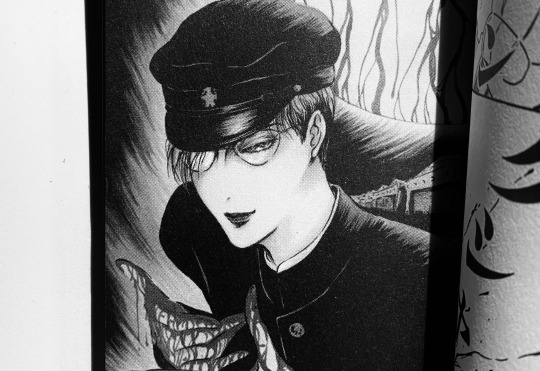
MOON AGE 15 : DAMNATION (English Translation) Moon Age 15: Damnation is a 1988 short comic by pseudonymous author Not Osada, who openly drew influence from the Tokyo Grand Guignol's work in such a way that can arguably give a loose insight to the TGG's mysteriously anomalous works. While only a slight window into what could've existed in Ameya's vision, each contemporary rendering of his world of gore-soaked medical equipment and rusted metal is valuable in what it represents. As mentioned in my prior Litchi essay, the fragments of the Tokyo Grand Guignol we have now are descendants of a cultural phantom, standing as shrouded windows to a strange intangible stage that's positioned somewhere between post-Maruo inferno, industrial subculture and decadent poetry. While Osada’s manga featured notably grizzly and cruelly morbid scenarios, his stories were made explicitly for the shoujo market with a distinctly shoujo-influenced art style. Characters appear almost doll-like with their visual perfections, all while they’re often dismantled and reassembled in bizarre surgical practices by sadistic doctors. Much like how Zera expresses horror to seeing his own imperfect organs in contrast with his youthful appearance, our pristine victims share the same internals as any other slaughtered cadaver, all in a maddening spiral of narratives that contemporary readers often described as resembling descents to insanity. This fixation of the contrast between perceived beauty and grotesqueness is arguably traced back to the Tokyo Grand Guignol’s own works, with lines accentuating the youthful features of certain characters while audience members were known to fondly look back on the actors’ appearances. Litchi himself was described as being a “cute” robot despite the violence it was programed to carry out. It’s possible that this collision is inherent to Ameya’s conceptual destruction of the TGG. A known detractor to poetic writing, he called on a romantic author to pen the screenplays to the TGG’s first three plays so he could “destroy” them in his direction. The use of beauty could arguably be a mockery of it, taking these idealized dolls and leaving them trapped in worlds of fascism and hospital rooms that are haunted by the stinging stench of antiseptics and blood. Plastic hospital drapes were used in place of stage curtains and autopsy films were shown to the wide-eyed characters, who spoke of pure blood and dirty blood, the antithesis of blood, mercuro. What is beauty a representation of in the Grand Guignol’s works with the prominent fascist leanings of the protagonists? Considering the perspectives of our characters where the Hikari Club and the deranged teachers and Nazi doctors are treated as protagonists rather than explicit antagonists, the plays could arguably be read as the decay of a self-convinced beauty under fascist rule. Songs of the pure-blooded ubermensch fading into silence as the singers all collapse, lost in their own delirium as they pump mercurochrome into their hearts and try to rationalize their own organs that resemble the internals of the so-called ‘landraces’ they rendered into lifeless meat. It’s the natural conclusion of fascism, a collapse that occurs in demented violence to the face of a denial of death. I was originally split on publicizing my translation due to copyright-related complications, but after seeing the increasing gatekeeping of TGG materials at the hands of a rapidly growing market riddled with competitive spending and scalping, I feel obliged to share it to the public who (like myself) can’t afford to spend the now literal hundreds that are required to access angura ephemera that was meant to be openly available to the public to begin with. When originally finding this story, the book it was featured in was only 5 dollars. Now it goes for 60 to 200. That's ridiculous. With all the preamble out of the way, the story is under the cut...



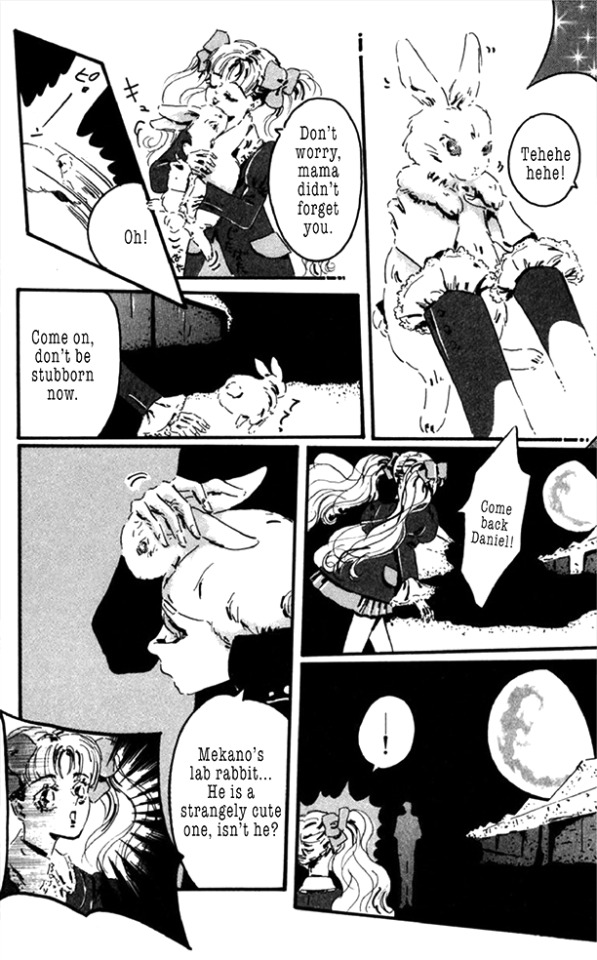


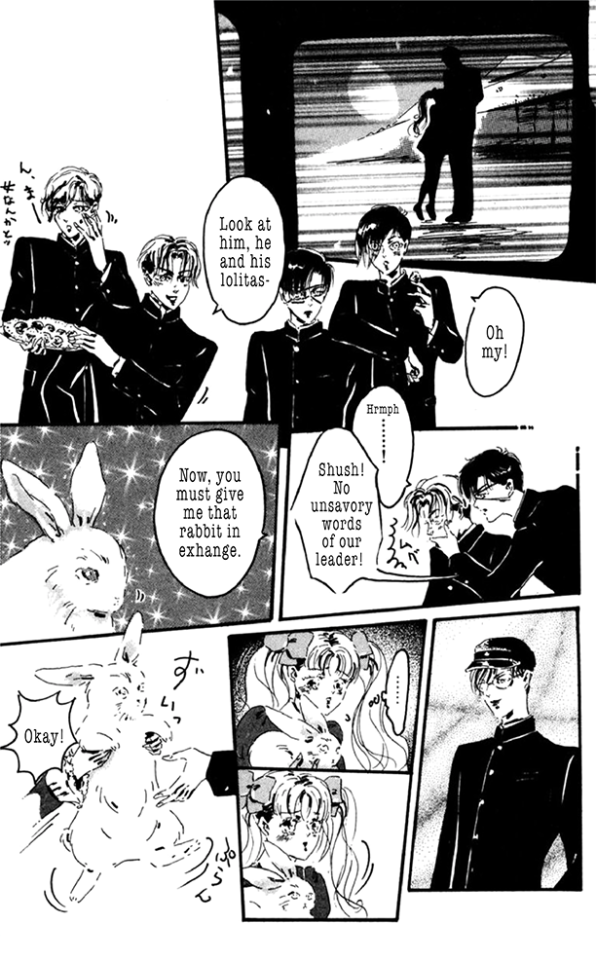
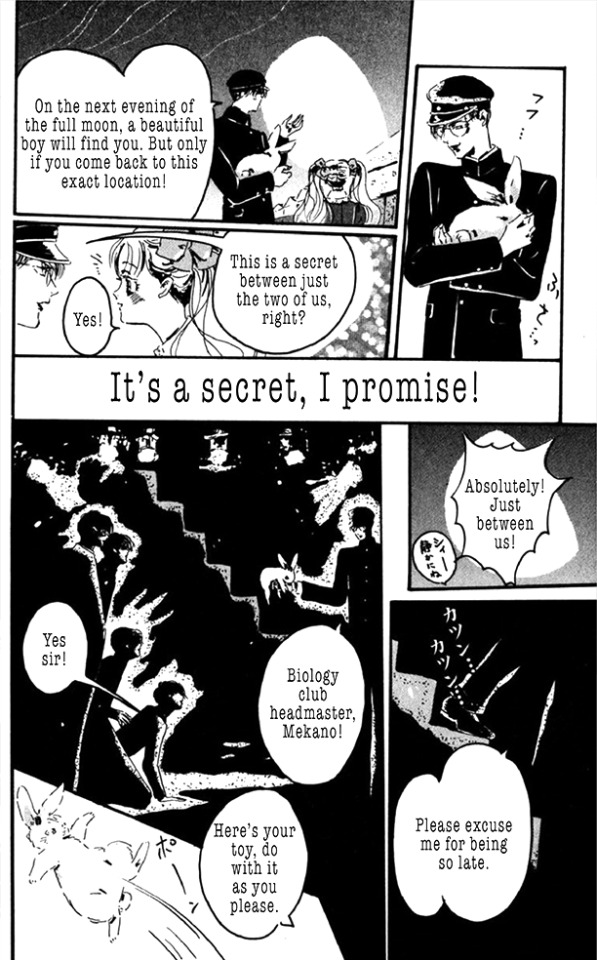
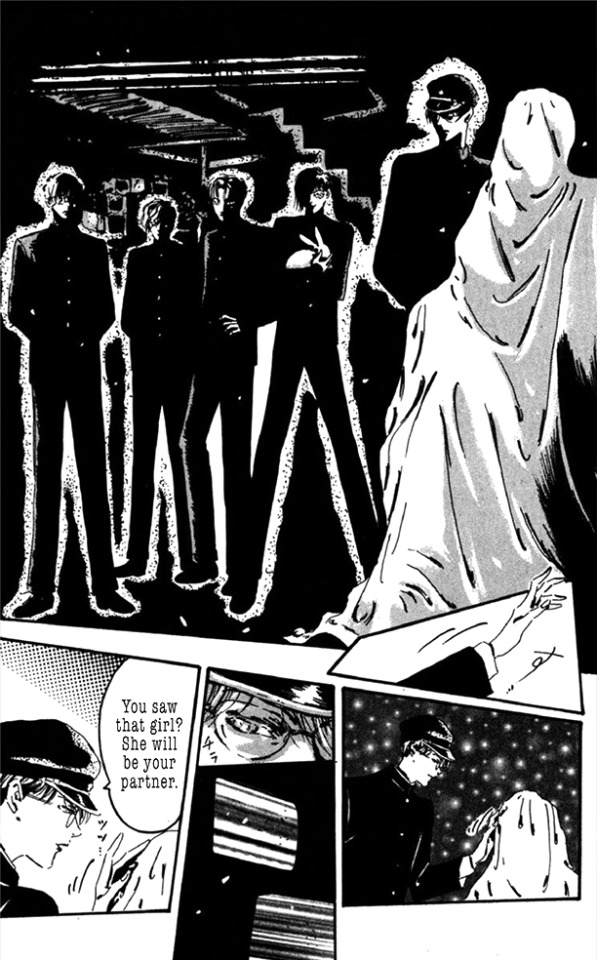
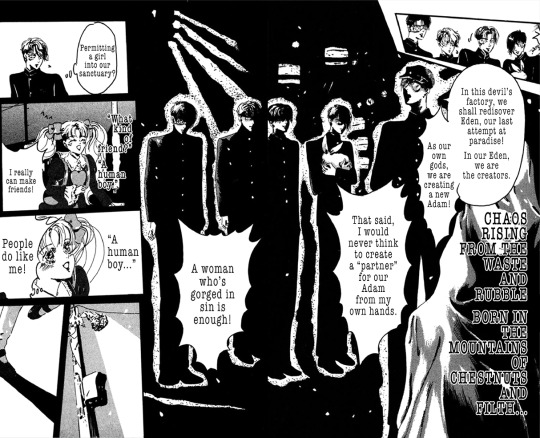
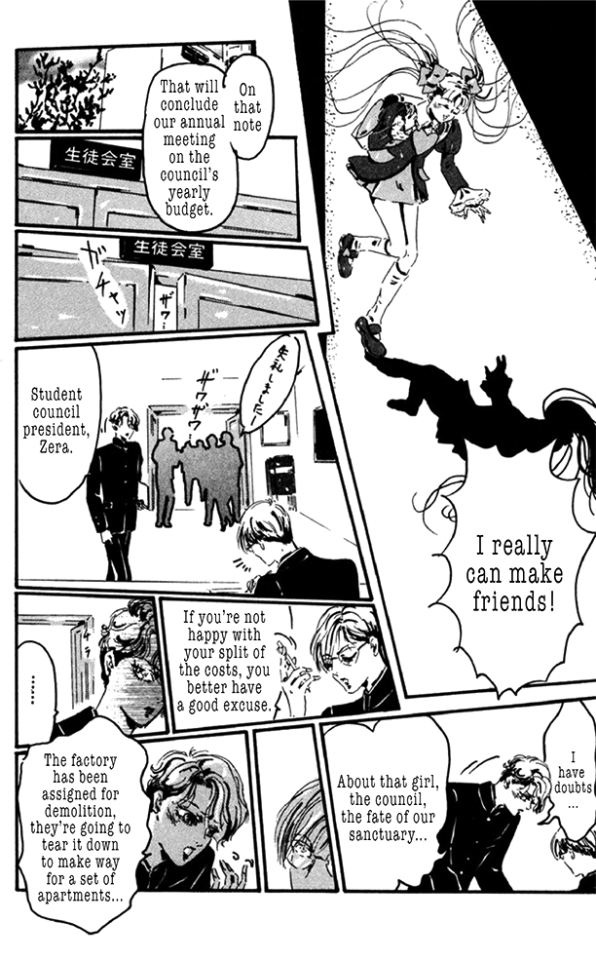
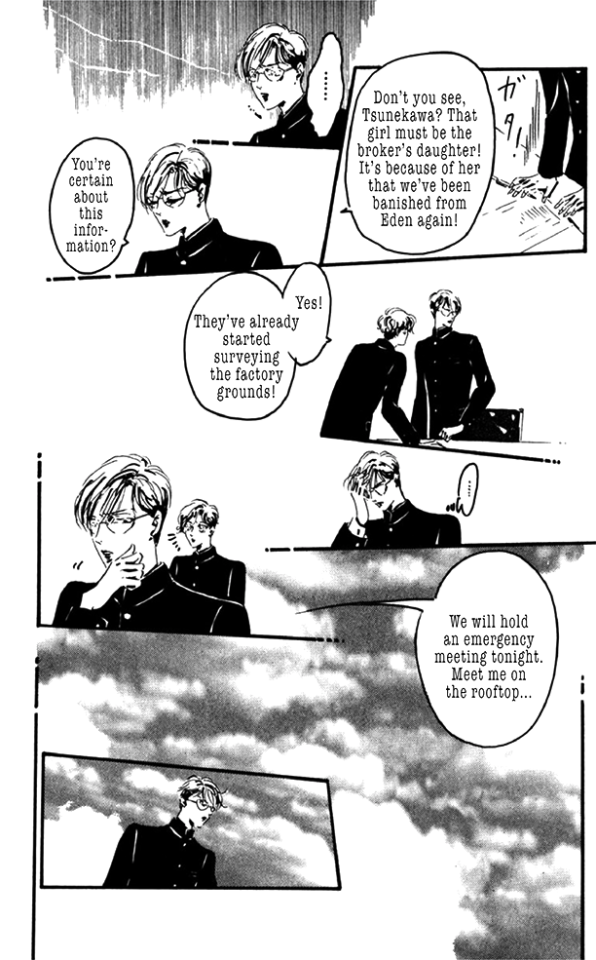
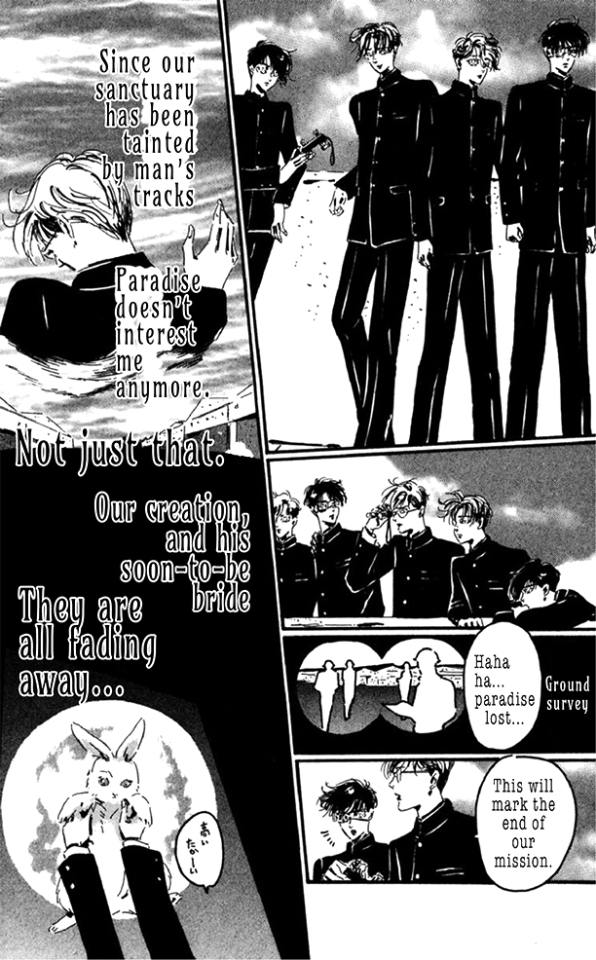

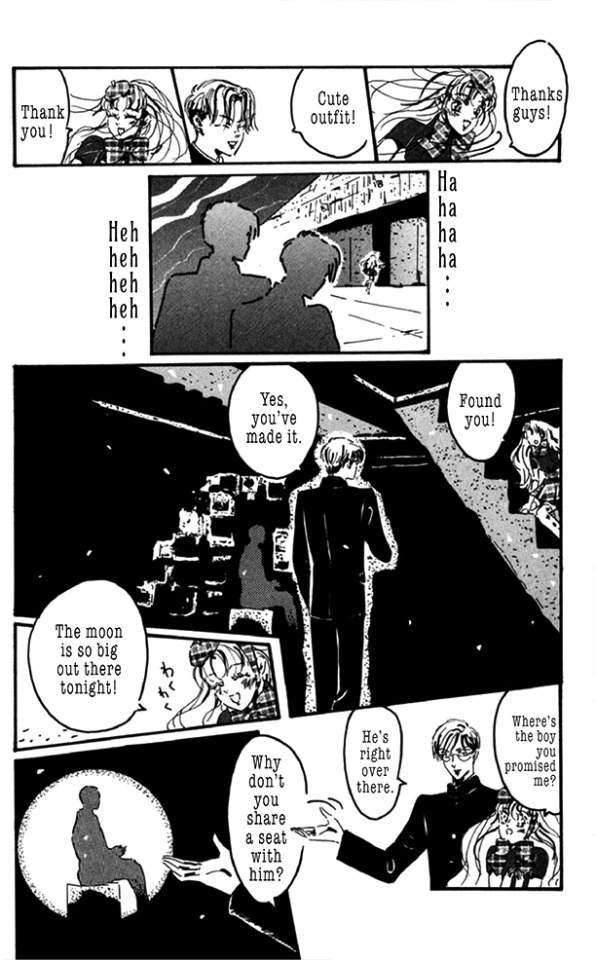
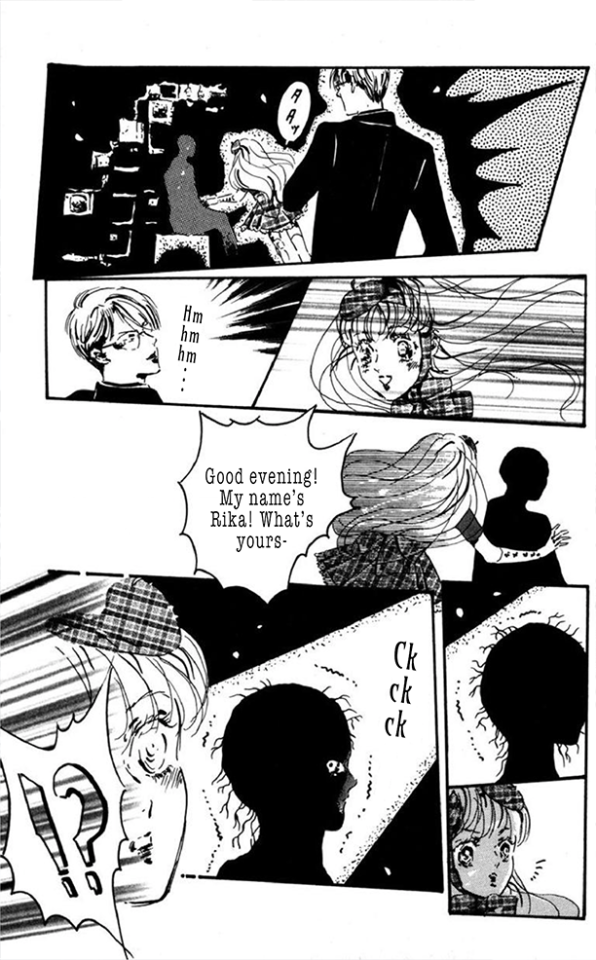




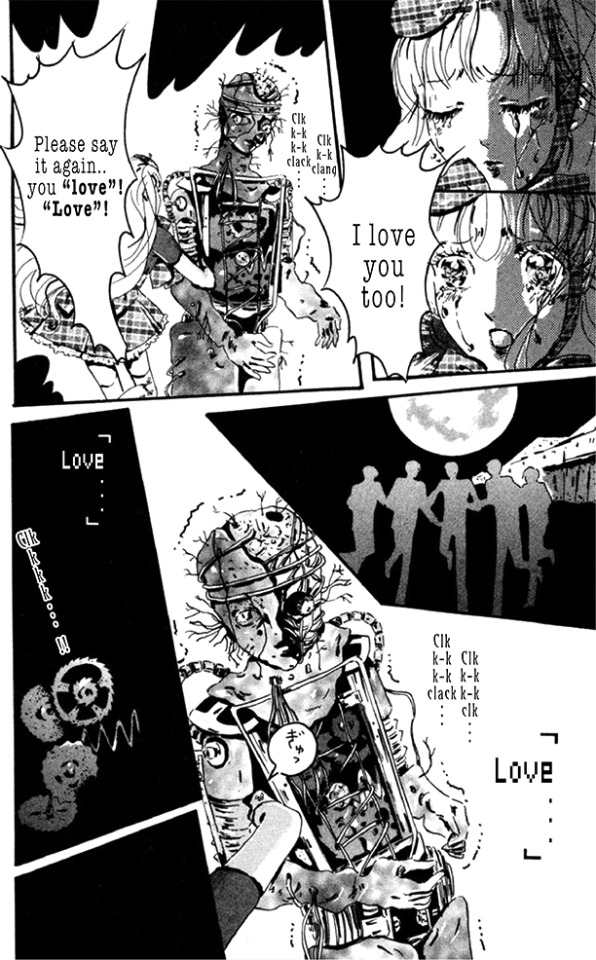
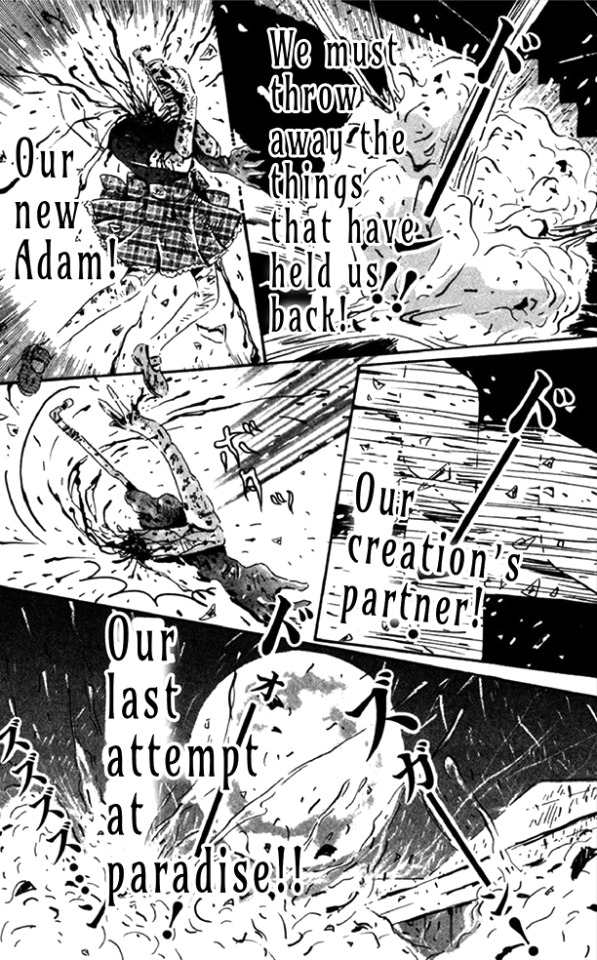

While I made my best effort to maintain accuracy to the source material in translation despite my practically nonexistent understanding of Japanese (my translation method is a Frankensteining of language learning videos, a Japanese to English dictionary from the Internet Archive and Google Translate with a lot of localizing and dissection in between), there are several details I feel I should note for the sake of transparency. One smaller one was the inclusion of the term l * lita. It was in the original text, and I was honestly very unsure of including it in my translation as it’s a term I’m personally icked out by. While I was ultimately recommended to keep the line as is for accuracy, I wish to state that it's a term I'm personally very uncomfortable with in what it represents. The other note, which is the more prominent one in the final product, are the references to The Last Attempt at Paradise. In the original text the club members solely refer to their hideout as paradise and Eden, leaving a lot of excess space in the speech bubbles after translation when making the shift from Japanese text to English. The Last Attempt at Paradise was the name of S.P.K.’s 1982 live album that documents their set at the Off the Wall Hall venue in Lawrence, Kansas. Often considered one of their best concerts and a highlight of the industrial genre, the S.P.K. Appreciation Society of Sydney in their All The Way With S.P.K. / American Tour article describes the concert as being the group's “best performance to date”, further adding that they “Flattened (an) enthusiastic audience with massive P.A. amplification of FX bass regeneration”. This insertion wasn’t done at random, as the Tokyo Grand Guignol’s works were heavily engrained in the original industrial scene of the 80s. Both the 1985 and 1986 performances of Litchi began on a playback of the S.P.K. song Culturcide (from their 1983 Dekompositiones EP), and it was likely that use of the track that led to Not Osada’s early fixation on S.P.K.’s music. At the end of Blind Beast, in a sort of reader Q&A Osada is questioned about some of his favorite music. At the top of the list he features the tracklist of the Dekompositiones EP and the track Mekano from their 1979 Mekano / Contact / Slogun single. Interestingly enough he states that he only likes those four songs from the band, following the text with laughter in regards to their remaining discography. I’m unsure if this means he was unimpressed with their noisier work (which would be curious knowing his liking of Mekano with how it originated from their earliest noise-adjacent album) or if he was directed to their later Machine Age Voodoo material and was alienated by it. In the same Q&A he also mentions the band Funeral Party, who featured specially commissioned art by Suehiro Maruo on their Dream of Embryo single. It's apparent that he also had a copy of the compilation album Vision Of The Emortion, as the list also includes C·C·Mekka and Ego'n Mole, who were both featured in the album alongside Funeral Party's only two other documented tracks, Das Sunde and Gears - Night. S.P.K. references are sprinkled throughout this story along with Osada's other Litchi-adjacent entries. Aside from one of Zera's henchmen being named after the Mekano track, it's very likely that the frequent references to Eden are in homage to the lyrics of Mekano. The first lines of the track include the verses "One by one, odd to even. Break the scenes, rudely eden...".
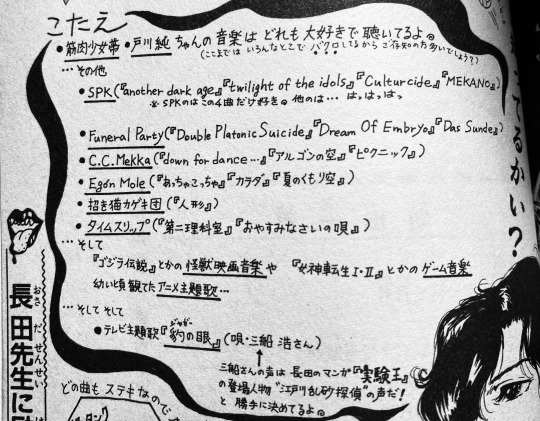
Moon Age 15 was originally printed in 1988 as a two-part miniseries in the horror magazine Complete Collection of Horror and Occult Works - HELP, namely in volumes 5 and 6. While being an early work that derived from the TGG, it still wasn’t the first comic to adapt the Litchi stage play, with Das Blut : Blood and Eternal Girl preceding it with their 1986 publication in Osada’s debut anthology Night Reading Room, sharing the same year as the TGG’s early closure following creative conflicts between Norimizu Ameya and K Tagane (the group's author, who remains anonymous to this day). It’s to be noted however that while Das Blut and Eternal Girl were the first stories to feature the Hikari Club as antagonists, they are only tangentially related with Moon Age showing more distinct Grand Guignol archetypes (musings of the full moon, examinations of the Hikari club’s misogyny, idealization of technology, and even an early rendition of the Litchi robot itself). First kept solely as a brief serial, Moon Age was later reprinted in abridged form as a short story in the 1996 Blind Beast anthology. While copies of HELP are notably hard to find and demand high prices, I was given an in depth view of both volumes that featured Moon Age’s serialization by a collector earlier last year. While the drawings are still the same on a rudimentary level, the length of the serialized version is notably longer than the later Blind Beast variant, with the HELP serialization being over 40 pages while Blind Beast’s is only 24. This was the product of the manga being entirely revised for Blind Beast’s print, with the layouts being drastically altered along with basic revisions of the line art. Certain scenes that would usually take 2 to 3 pages in the HELP version were condensed to 1, resulting in a unique tradeoff where one version feels unusually spacious in its framing while the other is heavily condensed and almost chaotic by comparison. It’s only a thing that springs on you once you compare the two variants, I saw the revised version first and originally didn’t pay any mind to it. One thing that is certain is the polishing of the art. The brush work in the Blind Beast version is refined with a more elaborate sense of weight and flow while the HELP version is notably rough with the prominent use of rudimentary screentones. It reflects as a somewhat rougher variant of the art shown in Night Reading Room. It feels strangely digital, like it’s the product of early computer art. The line-by-line reuse of the decapitation scene from Eternal Girl being shown on the TVs further adds to the strange digital feel of the art style.
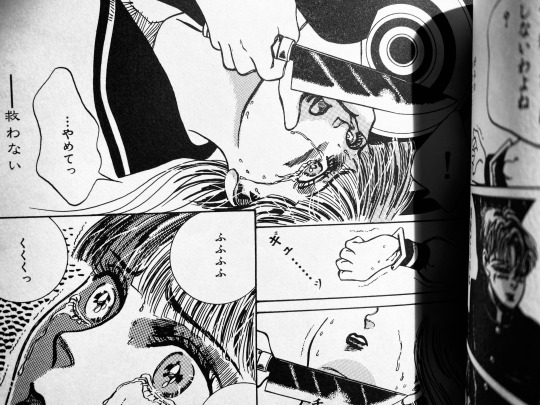

Similar to Moon Age, Osada's other stories of the Hikari Club featured the members luring girls to their brutal deaths. In Eternal Girl the members bring in a student and film her mutilation for a snuff film that acts as the story's namesake, in Das Blut they corner another student to the woods where they hang her, and in Jinta Jinta they kidnap a student who bullied one of her classmates to suicide before trepanning her with a strange device that's somewhere between an electric chair and a drill. Not Osada was very recently namedropped in the concluding essay of an English print of Kawashima Norikazu’s Her Frankenstein under the alternate Nagata Nooto anglicization of Osada’s pseudonym. Their name is a curious case as while there is a prominent written variant (長田ノオト), it’s seen numerous English iterations. In Osada’s own English signatures it is written as Not Osada (with the name apparently being derived from a German phrase), but other variants include Osada Nohto, Osada Nooto and Not Nagata. If I'm not mistaken, it could count as one of the first English acknowledgements of Osada's works in print.
64 notes
·
View notes
Text
lol was once again having the “who on Gilmore Girls would be a Swiftie?” convo with friends and this just kinda spilled out:
The year is 2023.
Much to Lorelai's chagrin and mocking, The Stars Hollow Blonde Mommy Brigade™️ spend the summer embroidering denim jackets and planning expensive caravans to shuttle their matching blonde children to multiple Eras tour stops. Luke happily has Lorelai's back on this one because he keeps finding those fucking little friendship bracelet beads in every nook and cranny of the diner. Jess thinks they should lighten up and let the kids have their fun. Lorelai knew she could never trust him.
Kirk won't stop selling the bracelets under the table at the diner. "Lulu has found her calling, Luke. The woman is a savant with plastic embellishments." Once Liz gets wind of it, she shows up with cases of her own to compete. Luke contemplates burning the whole building down.
There's a town meeting where Taylor proposes they have an Eras themed night in the square where they project the concert film and sell copious amounts of memorabilia. Think of the tourism! Lorelai and Luke show up to protest and are dismayed as one by one, each and every townie admits they love Taylor's music and support the event.
"Lane? Even you?" Lorelai gapes across the aisle.
"Hey, she's got some solid songs, Lorelai. Don't be a hater." Zach says. Brian shyly reveals his 1989 tattoo.
"I like her work with Bon Iver." Lane meekly admits.
"Et tu, brute?" Lorelai goes on to mock Bon Iver's singing voice, calling him the soy latte Brooklyn farmers market Michael McDonald. Her extended impression falls on deaf ears. Luke pats her on the knee for a noble effort.
Michel returns to work on Monday after a mysteriously vague long weekend wearing an Eras t-shirt underneath his suit jacket. Lorelai sticks her head in the sink.
She is a woman possessed. The final straw comes one fateful day in late November as Lorelai is lazily swiping through her instagram stories and sees folklore shamefully make Rory's Spotify Wrapped. Traitor! She complains so much that Rory relegates her venting to a designated Swiftie segment at the end of their nightly phone calls.
Rory doesn't take it all too seriously until she gets doxxed after writing a thinkpiece on her Substack entitled "Taylor Swift and the Capitalist industrial Complex".
Maybe her mom is onto something.
8 notes
·
View notes
Text
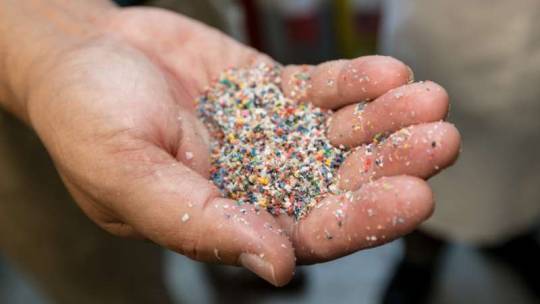
New recycling process could find markets for 'junk' plastic waste
Although many Americans deposit their plastic trash into the appropriate bins each week, many of those materials, including flexible films, multilayer materials and a lot of colored plastics, are not recyclable using conventional mechanical recycling methods. In the end, only about 9% of plastic in the United States is ever reused, often in low-value products. With a new technique, however, University of Wisconsin–Madison chemical engineers are turning low-value waste plastic into high-value products. The new method, described in the journal Science, could increase the economic incentives for plastic recycling and open a door to recycling new types of plastic. The researchers estimate their methods could also reduce greenhouse gas emissions from the conventional production of these industrial chemicals by roughly 60%. The new technique relies on a couple of existing chemical processing techniques. The first is pyrolysis, in which plastics are heated to high temperatures in an oxygen-free environment.
Read more.
#Materials Science#Science#Waste#Plastics#Polymers#Recycling#University of Wisconsin#Materials processing
32 notes
·
View notes
Text
Acetic Acid Market - Forecast(2024 - 2030)
Acetic Acid Market Overview
Acetic Acid Market Size is forecast to reach $14978.6 Million by 2030, at a CAGR of 6.50% during forecast period 2024-2030. Acetic acid, also known as ethanoic acid, is a colorless organic liquid with a pungent odor. The functional group of acetic acid is methyl and it is the second simplest carboxylic acid. It is utilized as a chemical reagent in the production of many chemical compounds. The major use of acetic acid is in the manufacturing of vinyl acetate monomer, acetic anhydride, easter and vinegar. It is a significant industrial chemical and chemical reagent used in the production of photographic film, fabrics and synthetic fibers. According to the Ministry of Industry and Information Technology, from January to September 2021, the combined operating revenue of 12,557 major Chinese garment companies was US$163.9 billion, showing a 9% increase. Thus, the growth of the textile industry is propelling the market growth for Acetic Acid.
Report Coverage
The “Acetic Acid Market Report – Forecast (2024-2030)” by IndustryARC, covers an in-depth analysis of the following segments in the Acetic Acid industry.
By Form: Liquid and Solid.
By Grade: Food grade, Industrial grade, pharmaceutical grade and Others.
By Application: Vinyl Acetate Monomer, Purified Terephthalic Acid, Ethyl Acetate, Acetic Anhydride, Cellulose Acetate, Acetic Esters, Dyes, Vinegar, Photochemical and Others
By End-use Industry: Textile, Medical and Pharmaceutical, Oil and Gas, Food and Beverages, Agriculture, Household Cleaning Products, Plastics, Paints & Coating and Others.
By Geography: North America (the USA, Canada and Mexico), Europe (the UK, Germany, France, Italy, Netherlands, Spain, Russia, Belgium and the Rest of Europe), Asia-Pacific (China, Japan, India, South Korea, Australia and New Zealand, Indonesia, Taiwan, Malaysia and the Rest of APAC), South America (Brazil, Argentina, Colombia, Chile and the Rest of South America) and the Rest of the World (the Middle East and Africa).
Request Sample
Key Takeaways
The notable use of Acetic Acid in the food and beverages segment is expected to provide a significant growth opportunity to increase the Acetic Acid Market size in the coming years. As per the US Food and Agriculture Organization, world meat production reached 337 million tonnes in 2019, up by 44% from 2000.
The notable demand for vinyl acetate monomer in a range of industries such as textile finishes, plastics, paints and adhesives is driving the growth of the Acetic Acid Market.
Increase in demand for vinegar in the food industry is expected to provide substantial growth opportunities for the industry players in the near future in the Acetic Acid industry.
Acetic Acid Market Segment Analysis – by Application
The vinyl acetate monomer segment held a massive 44% share of the Acetic Acid Market share in 2021. Acetic acid is an important carboxylic acid and is utilized in the preparation of metal acetates and printing processes, industrially. For industrial purposes, acetic acid is manufactured by air oxidation of acetaldehyde with the oxidation of ethanol, butane and butene. Acetic acid is extensively used to produce vinyl acetate which is further used in formulating polyvinyl acetate. Polyvinyl acetate is employed in the manufacturing of plastics, paints, textile finishes and adhesives. Thus, several benefits associated with the use of vinyl acetate monomer is boosting the growth and is expected to account for a significant share of the Acetic Acid Market.
Inquiry Before Buying
Acetic Acid Market Segment Analysis – by End-use Industry
The food and beverages segment is expected to grow at the fastest CAGR of 7.5% during the forecast period in the Acetic Acid Market. Acetic Acid is also known as ethanoic acid and is most extensively used in the production of vinyl acetate monomer. Vinyl acetate is largely used in the production of cellulose acetate which is further used in several industrial usage such as textiles, photographic films, solvents for resins, paints and organic esters. PET bottles are manufactured using acetic acid and are further utilized as food containers and beverage bottles. In food processing plants, acetic acid is largely used as cleaning and disinfecting products. Acetic acid is extensively used in producing vinegar which is widely used as a food additive in condiments and the pickling of vegetables. According to National Restaurant Association, the foodservice industry is forecasted to reach US$898 billion by 2022. Thus, the advances in the food and beverages industry are boosting the growth of the Acetic Acid Market.
Acetic Acid Market Segment Analysis – by Geography
Asia-Pacific held a massive 41% share of the Acetic Acid Market in 2021. This growth is mainly attributed to the presence of numerous end-use industries such as textile, food and beverages, agriculture, household cleaning products, plastics and paints & coatings. Growth in urbanization and an increase in disposable income in this region have further boosted the industrial growth in this region. Acetic acid is extensively used in the production of metal acetates, vinyl acetate and vinegar which are further utilized in several end-use industries. Also, Asia-Pacific is one of the major regions in the domain of plastic production which provides substantial growth opportunities for the companies in the region. According to Plastic Europe, China accounted for 32% of the world's plastic production. Thus, the significant growth in several end-use industries in this region is also boosting the growth of the Acetic Acid Market.
Acetic Acid Market Drivers
Growth in the textile industry:
Acetic Acid, also known as ethanoic acid, is widely used in the production of metal acetate and vinyl acetate which are further used in the production of chemical reagents in textiles, photographic films, paints and volatile organic esters. In the textile industry, acetic acid is widely used in textile printing and dyes. According to China’s Ministry of Industry and Information Technology, in 2020, textile and garment exports from China increased by 9.6% to US$291.22 billion. Also, according to the U.S. Department of Commerce, from January to September 2021, apparel exports increased by 28.94% to US$4.385 billion, while textile mill products rose by 17.31% to US$12.365 billion. Vinyl acetate monomer is utilized in the textile industry to produce synthetic fibers. Thus, the global growth in demand for textiles is propelling the growth and is expected to account for a significant share of the Acetic Acid Market size.
Schedule a call
Surge in use of vinegar in the food industry:
The rapid surge in population along with the adoption of a healthy and sustainable diet has resulted in an increase in demand for food items, thereby increasing the global production level of food items. As per US Food and Agriculture Organization, in 2019, global fruit production went up to 883 million tonnes, showing an increase of 54% from 2000, while global vegetable production was 1128 million tonnes, showing an increase of 65%. Furthermore, world meat production reached 337 million tonnes in 2019, showing an increase of 44% from 2000. Acetic acid is majorly used in the preparation of vinegar which is further widely utilized as a food ingredient and in personal care products. Vinegar is used in pickling liquids, marinades and salad dressings. It also helps to reduce salmonella contamination in meat and poultry products. Furthermore, acetic acid and its sodium salts are used as a food preservative. Thus, the surge in the use of vinegar in the food industry is boosting the growth of the Acetic Acid Market.
Acetic Acid Market Challenge
Adverse impact of acetic acid on human health:
Acetic Acid is considered a strong irritant to the eye, skin and mucous membrane. Prolong exposure to and inhalation of acetic acid may cause irritation to the nose, eyes and throat and can also damage the lungs. The workers who are exposed to acetic acid for more than two or three years have witnessed upper respiratory tract irritation, conjunctival irritation and hyperkeratotic dermatitis. The Occupational Safety and Health Administration (OSHA) reveals that the standard exposure to airborne acetic acid is eight hours. Furthermore, a common product of acetic acid i.e., vinegar can cause gastrointestinal tract inflammatory conditions such as indigestion on excess consumption. Thus, the adverse impact of Acetic Acid may hamper the market growth.
Buy Now
Acetic Acid Industry Outlook
The top 10 companies in the Acetic Acid Market are:
Celanese Corporation
Eastman Chemical Company
LyondellBasell
British Petroleum
Helm AG
Pentoky Organy
Dow Chemicals
Indian Oil Corporation
Daicel Corporation
Jiangsu Sopo (Group) Co. Ltd.
Recent Developments
In March 2021, Celanese Corporation announced the investment to expand the production facility of vinyl portfolio for the company’s acetyl chain and derivatives in Europe and Asia.
In April 2020, Celanese Corporation delayed the construction of its new acetic acid plant and expansion of its methanol production by 18 months at the Clear Lake site in Texas.
In October 2019, BP and Chian’s Zhejiang Petroleum and Chemical Corporation signed MOU in order to create a joint venture to build a 1 million tonne per annum Acetic Acid plant in eastern China.
Key Market Players:
The Top 5 companies in the Acetic Acid Market are:
Celanese Corporation
Ineos Group Limited
Eastman Chemical Company
LyondellBasell Industries N.V.
Helm AG
For more Chemicals and Materials Market reports, please click here
#Acetic Acid Market#Acetic Acid Market Share#Acetic Acid Market Size#Acetic Acid Market Forecast#Acetic Acid Market Report#Acetic Acid Market Growth
2 notes
·
View notes
Text
COME ON BARBIE LET GO PATRIARCHY

Something was different.
Yes, here is a huge hit, female directed, female written and female starring - breaking just amazing records. The first live action comedy to break the top 20 biggest opening weekends. First female directed, written and focused film in that top 20. 162 Million dollar opening weekend. Indiana Jones by comparison only did $60 million domestically and that was cherished cinematic IP with a male protagonist. Mission Impossible didn't crack 100 million and it too had a male protagonist. And it wasn't a holiday weekend. Just another weekend dead in the middle of summer with a huge iMax sized competitor in the Nolan film Oppenheimer - which probably did benefit more from Barbie than Barbie did from it in large part thanks to the genius double feature marketing of Barbieheimer. And some people apparently only saw Oppenheimer because Barbie was sold out.
But wait - so the male starring films all under performed? And Barbie DOUBLED Oppenheimer's take??
And worldwide - it's made over $400 million dollars! Surpassing Jones and Impossibley beating Mission Impossible. Already. In it's first week of release.
Every male driven movie this summer, aside from the testosterone filled mustache of Mario, had weak turnout. Yet the narrative from the industry has been that female centered films don't have enough demand. That people won't turn out for a movie about women and girls and for women and girls.
Yet...here we are...Barbie.
But that's not what I mean by different.
The film is unique. It wasn't what I expected. I thought it might be a fish out of water story in the real world like Enchanted. Or have some quest component whereby Barbie would need to find the hidden McGuffin golden slipper or devise some magic potion to stop some great evil from shooting a laser in the sky, again.
Instead I was met with fantasy.
A film structured and written as if kids were playing with their Barbies but not just kids - as if kids were playing Barbie with their Moms and their Moms were using the toys to educate their kids on the suffocating yoke of the male patriarchy.
But entire film felt like one long playdate with the truth.
From how Barbie magically moves to the ground or travels in between worlds - there's an active surreal quality where one action doesn't necessarily need explanation - she just is now on Venice Beach. She's just now in a white void. She's just now in Ben Shapiro's crawl keeping him from his precious beauty sleep.
But that's not what was different.
And though the film was almost a movie about Barbie AND Ken equally, with both having large arcs and equal screen time, where Ken wasn't just a supporting player but seemingly as much of a center of the movie as Barbie - with performances from Robbie and Gosling that were anything but plastic - but that's not what struck me as different...
Something happened in the theatre.
As the credits started to roll...
...normally everyone sits and maybe waits for an end credit scene quietly or simply slips out in silence...
...this time...
...as soon as the credits rolled...
...the whole theatre started talking, chatting, excitedly with each other, there was such a roar that you couldn't hear Billie Elish's whisper singing during the final song in the credits.
I've never really heard that before. That was different. Not Billie Elish’s whisper singing - will somebody please get that poor lady a throat losenge.
The chatter. The audience was awake.
There was an excitement. An eagerness to digest what they just saw. A glee.
And it was mostly a female audience.
Well I did hear one man explaining what he thought and say the word existential just a lot - there's always one Ken.
But it was different. This film managed to do something new. And it's honesty and straight forwardness and clarity was refreshing. It didn't just speak in metaphor - it at times just out right said the thing that needed to be said - that men needed to hear. And said them several times. Why? Because, speaking as someone who walks between both worlds, sometimes you have to tell a man something more than once for him to get off his ass and take the damn trash out.
And yet it didn't end on women taking control. The goal wasn't vengeance or domination - the goal was acceptance and ultimately...equality. We just aren’t there yet. Huh...a realistic ending to a plastic world.

#barbie
20 notes
·
View notes
Text
Zhejiang Chingleung New Material Technology Co.,Ltd.
About us
Jingliang Technology was established in 1995. The group includes Jingliang Technology (Suzhou Co., Ltd. and Zhejiang Jingliang New Materials Technology Co., Ltd.) and 23 branches at home and abroad. The Suzhou factory is located in the industrial park adjacent to the brilliant Jinji Lake and Dushu Lake, with masterbatch new materials as its main business; the Zhejiang factory is located in Yonghe Industrial Zone, Shangyu, Shaoxing, adjacent to the beautiful Siming Lake, with a forest oxygen bar and extremely convenient transportation. In recent years, with the further regulation and advocacy of environmentally friendly materials by the state, people's lives are increasingly closely linked to green products. Zhejiang Jingliang has specially established an environmentally friendly biodegradable material and product research and development expert team, focusing on the research and development, production and sales of biodegradable materials, biodegradable masterbatches and a series of biodegradable products such as 3D printing wires, straws, cups, tableware, shopping bags, packaging bags, garbage bags, express bags, films and sheets, etc. The group has internationally advanced color matching systems, high-end extrusion production lines, high-grade dust-free clean workspaces, the latest 3D Printing wire, film, sheet, straw, cup, bag, tableware and other manufacturing equipment and many complete testing equipment have created green products with both scientific and practical features. In order to bring better products and services to customers, the group passed the S9001.2000 international quality certification in 2000; UL safety certification; QS certification; the products have also been tested by the SGS authoritative testing agency and UL safety agency, and all meet environmental protection standards; and passed the tests required for domestic and foreign market access GB/T19277.1-2011, GB/T 18006.3-2020, GB/T 38727-2020, GB/T3 8082-2019, etc., in line with the testing of ASTMD, EN13432 and certification DIN Certco, BPI, OK biobased, OK compostable, USDA, etc., providing complete environmentally friendly plastic packaging solutions for large domestic and foreign companies.
2 notes
·
View notes
Text
How High-Performance Stretch Film Transforms Shipping in Vietnam
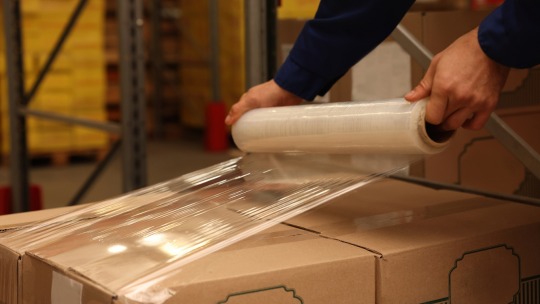
Efficient shipping is becoming increasingly vital in Vietnam's booming economy. From bustling markets to high-tech industrial zones, the need for effective transportation and secure packaging has never been greater. Enter high-performance stretch film—a game-changer that's transforming the way Vietnamese businesses handle shipping. This guide will show you how high-performance stretch film can enhance your shipping processes, reduce costs, and improve overall efficiency.
The Basics of Stretch Film
What is Stretch Film?
Stretch film is a highly stretchable plastic film used to wrap products on pallets, ensuring they remain secure during transit. Its primary purpose is to hold loads tightly together, preventing them from shifting, tipping, or getting damaged. This makes it an essential tool in the shipping and logistics industry.
Types of Stretch Film
There are two main types of stretch film—cast and blown. Cast stretch film is produced using a continuous process called casting, which results in a clear, glossy film. It offers excellent clarity, making it easier to identify wrapped products. On the other hand, blown stretch film is manufactured using a blown extrusion process, resulting in a more robust and tear-resistant film with a matte finish. Each type has its own strengths and is suitable for different applications.
Key Attributes of High-Performance Stretch Film
High-performance stretch film boasts several key attributes that set it apart from standard films. These include superior stretchability, puncture resistance, and load retention capabilities. These features ensure that high-performance stretch film provides better protection and stability for your shipments, making it an invaluable asset in the shipping process.
Selecting the Right Stretch Film for Your Needs
Factors to Consider
Choosing the right stretch film involves considering several factors, including the size and weight of your load, as well as the shipping conditions. Heavier loads may require a thicker, more robust film, while lighter loads can be secured with a thinner film. Additionally, consider the shipping environment—will your products be exposed to extreme temperatures or rough handling? These factors will help determine the most suitable stretch film for your needs.
Environmental Considerations
In today's environmentally conscious world, opting for sustainable and eco-friendly stretch films can make a significant difference. Look for films made from recyclable materials or those that use less plastic without compromising on strength and durability. This not only helps reduce your carbon footprint but also aligns your business with global sustainability initiatives.
Cost-Effectiveness
Balancing quality with budget constraints is crucial when selecting stretch film. While high-performance stretch film may come at a higher initial cost, its enhanced durability and efficiency can lead to long-term savings. Invest in quality stretch film to minimize material usage and reduce the risk of product damage during transit, ultimately lowering your overall shipping costs.
Benefits of Using High-Performance Stretch Film
Enhanced Load Stability and Protection
One of the primary benefits of high-performance stretch film is its ability to provide enhanced load stability and protection. The superior stretchability and load retention capabilities ensure that your products remain securely wrapped throughout the shipping process, reducing the risk of damage or loss.
Reduction in Material Usage and Cost Savings
High-performance stretch film is designed to maximize efficiency, requiring less material to achieve the same level of protection as standard films. This reduction in material usage translates to cost savings, making it a cost-effective solution for businesses of all sizes.
Increased Efficiency in Packing and Handling
Using high-performance stretch film can significantly improve the efficiency of your packing and handling processes. Its superior stretchability and puncture resistance mean fewer breaks and interruptions, allowing for smoother and faster wrapping. This increased efficiency can lead to faster turnaround times and improved overall productivity.
Compliance with Vietnamese Regulatory Standards
Adhering to regulatory standards is essential for businesses operating in Vietnam. High-performance stretch film complies with Vietnamese regulatory standards and best practices, ensuring that your shipments meet all necessary requirements. This compliance helps build trust with customers and partners, reinforcing your commitment to quality and reliability.
2 notes
·
View notes
Text
Song of the day: August 8 2024
Through Glass by Stone Sour
About Stone Sour:
Stone Sour was an American rock band formed in Des Moines, Iowa, in 1992. The band performed for five years before disbanding in 1997. They reunited in 2000 and since 2015, the group has consisted of Corey Taylor (lead vocals, guitar), Josh Rand (guitar), Christian Martucci (guitar), Johny Chow (bass) and Roy Mayorga (drums). Longtime members Joel Ekman (drums, percussion) and Shawn Economaki (bass guitar) left the band in 2006 and 2011, respectively. Former lead guitarist Jim Root left in 2014. The band has been on an indefinite hiatus since 2020.
(Via Wikipedia)
About Through Glass:
“Through Glass” is the second single on the album “Come What(ever) May” by American rock band Stone Sour. The track was published online through Yahoo! on July 22, 2006. The highest peaking of “Through Glass” was in the United States, on the US Billboard Hot Mainstream Rock Tracks, at number one, followed by number two on the US Billboard Hot Modern Rock Tracks. “Through Glass” was certified Platinum in the United States by the RIAA.
The corresponding music video for “Through Glass” was directed by Tony Petrossian.
“Through Glass” has also integrated itself into pop culture and appeared in the 2012 horror film, Grave Encounters 2.
The song was inspired by frontman Corey Taylor’s frustrations towards the music industry and how he felt that there had been no musical revolution at all. He had been quoted saying:
"I remember exactly where I was. It was 2004 and I was on tour with Slipknot. I was sitting in a European hotel room watching a music video channel, seeing act after act after act of this insane, innocuous, plastic music. They were plastic, bubbly, gossamer-thin groups where it was really more about the clothes they wore and the length of their cheekbones than it was about the content of the song they were singing. It really made me mad. I was like, “Is this it? Have we just gone full circle? Did the singer/songwriter revolution never happen? Is it just the same drivel from the same replicate over and over again?” … “Through Glass” is really a very angry song. It’s me basically calling bullshit on pretty much everyone involved with the American Idol-type shows. It has its place, but when you’re basically cornering the market and making it very hard for anyone who actually writes their own music to get ahead, then it’s wrong and that’s really why I wrote this song."
(Via genius.com)
2 notes
·
View notes
Text
Barbie is everything. He’s just … Robert Oppenheimer.
That’s right. The main character competing with Barbie for attention right now isn’t Ken, her plastic significant other. It’s the man who designed the atomic bomb.
Fans have been waiting for this summer’s release of two movies — “Barbie,” from Warner Bros. and directed by Greta Gerwig, and “Oppenheimer,” from Universal Pictures and directed by Christopher Nolan — which are both coming out on July 21, and they have been poking fun at the stark contrast in the movies’ themes, moods and color schemes.
The result of the release schedule is a mash-up many people may not have seen coming: Barbenheimer. Or Boppenheimer, if you will.
“Oppenheimer” is Nolan’s prestige movie based on “American Prometheus,” a biography of Oppenheimer, the scientist who led the Manhattan Project, which during World War II produced the first atomic bombs. The trailers for that film, with intense music and suspenseful scenes starring a pensive-looking Cillian Murphy as Oppenheimer, are in stark contrast with the pink and sparkly trailers for “Barbie,” which show Margot Robbie as the doll living in Barbieland before setting off on an adventure into the real world.
The two characters could hardly be more different (does this Venn diagram even have a middle?). And yet, Robbie and Murphy are appearing on T-shirts and sweaters together.
Memes, videos and online chatter have flooded social media, and some people are making plans to see the two movies on the same day. A debate about which order to see them in — “Barbie” first to start the day off light, or “Oppenheimer” first, to end on a more cheerful note — hasn’t been settled.
The curious crossover is also giving rise to real-life merchandise. A Google search for “Barbenheimer T-shirt” brings tens of thousands of results, and sellers on Etsy have designed their own versions. Some feature Robbie and Murphy, while others combine Barbie’s pink font with a pink drawing of an atomic cloud.
One such T-shirt, and an early entry in the crowded field, is a simple split-screen combination of the two movie logos, spelling out “Barbenheimer” with the release date of the films.
Hunter Hudson, 23, a filmmaker in San Antonio, said he originally designed and created the shirts for him and his friends to “roll up to the Barbenheimer double feature” on July 21. But when he posted pictures of the shirt on his Twitter feed, he said, it took off beyond his expectations.
“I normally get about three or four likes on anything I post,” Hudson said. But after sharing a few mock-ups of the shirt, he woke up one morning to hundreds of messages from people asking him if they could buy it.
Hudson makes the shirts himself, with a friend, and charges $40. So far he said he had made about 150 shirts, with a second batch of about 70 more on the way. It takes him about 45 minutes to an hour to make one T-shirt, which he does by cutting two shirts in half, pinning them together and sewing and pressing them.
“I had a couple of movie theaters reach out to me privately to do bulk orders for employees,” he said. “It’s been overwhelmingly positive.”
This kind of organic marketing is probably good for both films, said Robert Mitchell, the director of theatrical insights at Gower Street, a company that does predictive analysis for the film industry.
Not that the studios’ marketing has been lacking: There are life-size cardboard Barbie boxes in theaters for people to take pictures and a selfie generator. There have been collaborations with multiple brands: The frozen yogurt chain Pinkberry is offering a Barbie flavor, Gap has a line of Barbie-themed clothes, and Airbnb is offering a real-life Barbie Dream House in Malibu. Warner Bros. declined to comment on the movie’s marketing efforts.
What all this hype means for box office results for either film is unclear, and awareness doesn’t always translate into attendance, Mitchell said. Predictions for opening weekends are tricky and a lot can still happen before July 21, said David Gross, a movie consultant who publishes a newsletter��on box office numbers. Some conservative industry estimates, he said, have “Barbie” opening between $55 million and $65 million in the United States and Canada, and “Oppenheimer” between $40 million and $50 million. Both of those estimates would be strong for a fantasy comedy and a historical drama, neither of which are sequels. Superhero, big action and big animation movies usually open higher, Mr. Gross said.
Still, the hype around the films could be beneficial to the numbers. “Every time ‘Barbie’ released a trailer, ‘Oppenheimer’ would start trending,” Mitchell said.
“They’re so vastly different,” he said, “that they allow for the narrative that popped up organically: This would be strangest double bill ever.” That online conversation, he said, “is pretty much a gift for distributors.”
While social media is full of people showing off their tickets to see the double feature, it’s unclear how many really will. “But it shouldn’t matter,” Gross said. “Audiences are going to find them, and both films are going to do extremely well.”
11 notes
·
View notes
Text
Zero Friction Coatings Market: Charting the Course for Enhanced Performance and Sustainable Solutions
The global zero friction coatings market size is estimated to reach USD 1,346.00 million by 2030 according to a new report by Grand View Research, Inc. The market is expected to expand at a CAGR of 5.6% from 2022 to 2030. Growth can be attributed to the fact that these coatings reduce friction and wear resulting in low fuel consumption and less heat generation. According to the European Automobile Manufacturers' Association, 79.1 million motor vehicles were produced across the globe in 2021 which was up by 1.3% as compared to 2020. Zero friction coatings can extend the time between component maintenance and replacement, especially for machine parts that are expensive to manufacture.

Zero Friction Coatings Market Report Highlights
In 2021, molybdenum disulfide emerged as the dominant type segment by contributing around 50% of the revenue share. This is attributed to its properties such as low coefficient of friction at high loads, electrical insulation, and wide temperature range
The automobile & transportation was the dominating end-use segment accounting for a revenue share of more than 35% in 2021 due to the rapid growth of the automotive industry across the globe
The energy end-use segment is anticipated to grow at a CAGR of 5.7% in terms of revenue by 2030, owing to the excessive wear on the drill stem assembly and the well casing during the drilling operations in the oil and gas sector
In Asia Pacific, the market is projected to witness the highest CAGR of 5.8% over the predicted years owing to the presence of car manufacturing industries in the countries such as Japan, South Korea, and China
For More Details or Sample Copy please visit link @: Zero Friction Coatings Market Report
Several applications in the automobile industry use wear-resistant plastic seals that require zero tolerance for failure and lifetime service confidence. Increasing demand for the product from the automotive industry across the globe for various applications including fuel pumps, automatic transmissions, oil pumps, braking systems, and others is expected to drive its demand over the forecast period.
Low friction coatings can be used in extreme environments comprising high pressure, temperatures, and vacuums. These coatings can provide improved service life and performance thereby eliminating the need for wet lubricants in environments that require chemicals, heat, or clean room conditions. The product containing molybdenum disulfide (MoS2) are suitable for reinforced plastics while those free from MoS2 are suitable for non-reinforced plastics.
Zero friction coatings are paint-like products containing submicron-sized particles of solid lubricants dispersed through resin blends and solvents. The product can be applied using conventional painting techniques such as dipping, spraying, or brushing. The thickness of the film has a considerable influence on the anti-corrosion properties, coefficient of friction, and service life of the product. Its thickness should be greater than the surface roughness of the mating surfaces.
ZeroFrictionCoatingsMarket #FrictionlessTechnology #CoatingInnovations #IndustrialEfficiency #ZeroFrictionSolutions #AdvancedMaterials #SurfaceCoatings #ManufacturingAdvancements #GlobalIndustryTrends #InnovativeCoatings #PerformanceOptimization #MechanicalSystems #SustainableTechnology #IndustrialApplications #FutureTech #InnovationInMaterials #EfficiencySolutions #ZeroFrictionMarket #TechnologyInnovation #EngineeringMaterials
#Zero Friction Coatings Market#Frictionless Technology#Coating Innovations#Industrial Efficiency#Zero Friction Solutions#Advanced Materials#Surface Coatings#Manufacturing Advancements#Global Industry Trends#Innovative Coatings#Performance Optimization#Mechanical Systems#Sustainable Technology#Industrial Applications#Future Tech#Innovation In Materials#Efficiency Solutions#Zero Friction Market#Technology Innovation#Engineering Materials
2 notes
·
View notes
Text
Cling Film Market Trends, Segmentation, Outlook, Industry Report to 2031
The cling film market is anticipated to grow at a CAGR of 5.2% during the anticipated time frame and reach USD 8.72 billion by 2027. Food items are routinely wrapped and preserved with cling film, a thin plastic sheet also known as plastic wrap or food wrap.
The sector is developing mainly due to rising customer demand for packaged and handy items as well as increased consumer education on food safety and storage. Cling film is frequently used in homes, restaurants, and the food processing and packaging industries to preserve food for a longer period of time.
Low-density polyethylene (LDPE), polyvinyl chloride (PVC), and linear low-density polyethylene (LLDPE) are the three material kinds that make up the market. Because of its exceptional clarity, strength, and flexibility, PVC is the cling film material that is used the most frequently.
For More Insights on this Market, Get A Sample Report @ https://www.futuremarketinsights.com/reports/sample/rep-gb-2654
The effects of cling film on the environment, however, are also a worry. In landfills, plastic cling film takes hundreds of years to decompose, which can contribute to environmental contamination. Due to this, there is an increasing need for cling film substitutes like silicone food covers and beeswax wraps.
Overall, it is anticipated that the cling film market will expand over the next few years due to the rising demand for practical and secure food packaging solutions. To fulfil the changing expectations of consumers, the industry will also need to address worries about the environmental impact of plastic cling film and investigate sustainable alternatives.
Market Benefits
The study provides an in-depth analysis of the global Cling Film market along with the current trends and future estimations to elucidate the imminent investment pockets.
The key market players along with their strategies are thoroughly analyzed to understand the competitive outlook of the industry.
An extensive analysis of the market based on application assists in understanding the trends in the industry.
The report presents a quantitative analysis of the market from 2021 to 2031 to enable stakeholders to capitalize on the prevailing market opportunities.
Key Takeaways from the Cling Film Market Study
Polyvinyl chloride is expected to create incremental opportunity of US$ 508.3 million by 2031. It is cost-effective and suitable for recycling processes.
Cling film products up to 9 microns in thickness is estimated to increase 1.7 times by the end of 2031, attributed to clear and transparent packaging for food product displays.
Canada is expected to reflect faster growth in North America, with a 6.5% CAGR due to the presence of key players and the availability of technological advancements.
Germany leads Western Europe accounting for 26% of the value share by 2031, owing to relatively higher production capacity.
China will continue to dominate APEJ holding over 40% of the market through 2031, supported by a large base of end users and manufacturers.
Are you looking for customized information related to the latest trends, drivers, and challenges? @ https://www.futuremarketinsights.com/customization-available/rep-gb-2654
Competitive Landscape
Berry Global Group, Inc.
Intertape Polymer Group (IPG)
Gruppo Fabbri Vignola S.p.A
Kalan SAS
Fine Vantage Limited
Rotofresh – Rotochef s.r.l.
Manuli Stretch S.p.A.
Cling Film Market by Category
By Material type:
Polyethylene
Low Density Polyethylene (LDPE)
High Density Polyethylene (HDPE)
Linear Low Density Polyethylene (LLDPE)
Bi-axially Oriented Polypropylene (BOPP)
Polyvinyl Chloride
Polyvinylidene Chloride
Others
Speak to Our Analyst @ https://www.futuremarketinsights.com/ask-the-analyst/rep-gb-2654
By Thickness:
Up to 9 micron
9 to 12 micron
Above 12 micron
By End Use:
Food
Meat
Seafood
Baked Foods
Dairy Products
Fruits & Vegetables
2 notes
·
View notes
Text
In Saint-Léon close to Bordeaux is located a “laboratory” that gives new life to plastic waste

At the crossroads of contemporary design and the circular economy, the Plastiquerie manufactures sustainable furniture from recycled plastic.
So what do the big yellow and blue bags from Ikea or the construction helmets from the manufacturer Vinci have in common? They are made of a plastic material that can be recycled to make new objects. “Recycled plastic is a material with endless possibilities that I want to make known to designers. It’s a bit like the marble of the Anthropocene”, explains Julie Robert, co-founder of La Plastiquerie [1] based in Saint-Léon[2], about thirty kilometres south-east of Bordeaux.
Shelves, furniture or floor tiles
Since 2021, the independent artistic director has been passionate about this raw material, she has learned the properties of in order to manufacture designer objects and furniture. The association recovers plastic waste in polypropylene (PP)[3], polyethylene (PE)[4] or polystyrene (PS)[5] to give them a second life. “PET[6] waste such as plastic bottles already benefit from recycling solutions. I focus on families of plastics that are still poorly revalued”, she specifies. Protective films, water tubes from construction sites or industry off-cuts from yoghurt pots are thus treated in a 100 m² workshop housed in the premises of the Syndicate of the Entre-deux-Mers-West-region for the Collection and Treatment of Household Waste[7].
There, under a sheet metal shed, a shredder and a hot press transform the collected waste into confetti and then into large recycled plastic plates that will be used to make shelves, furniture or floor tiles. “La Plastiquerie is a laboratory where we develop prototypes of objects resulting from the recovery of plastic. From cans and flowerpots, for example, I imagined a wall light that saves 980 grams of plastic from landfill and incineration,” explains the entrepreneur.
"Companies want to recycle their own waste"
Although the Plastiquerie was co-founded with another woman, Amandine Boutang, Julie Robert now works alone, sometimes helped by an intern and supported by a board of directors, on her experiments with furniture designed in recycled and recyclable plastic. She is thinking about a waste sorting cabinet for the canteen of the Suez[8] headquarters in Occitanie-Nouvelle Aquitaine[9]. For the Bordeaux start-up Arits[10], she is working on the design of a lamp. A bank has also just approached her for an interior design project…
"Companies come naturally to the association because they want to recover their own waste or participate in the circular economy", rejoices the forty-year-old who wants to sharpen her expertise on recycled plastic to convince designers to adopt it. Two years after the launch of her project, Julie Robert draws a positive balance sheet: “I discovered the world of the circular economy where the actors are positive, imaginative people, full of energy and solutions. A world in which a great breath of optimism is sweeping in which I find myself.”
Source
Florence Donnarel, A Saint-Léon, un «laboratoire» pour donner une nouvelle vie aux déchets plastiques, in : Libération, 9-01-2023, https://www.liberation.fr/forums/a-saint-leon-un-laboratoire-pour-donner-une-nouvelle-vie-aux-dechets-plastiques-20230109_72VUV54KQJBBJGALYJ2C2FTORQ/
[1] Plastic is far from fantastic when it comes to recycling. At La Plastiquerie, we collect non-recycled deposits to revalorize them and produce small and medium design series. Its objective: to transform plastic waste into highly desirable objects and furniture! http://www.laplastiquerie.com
[2] Saint-Léon is a commune in the French department of Gironde (Nouvelle-Aquitaine region) and has 242 inhabitants (1999). The place is part of the arrondissement of Bordeaux.
[3] Polypropylene is the second-most widely produced commodity plastic (after polyethylene). In 2019, the global market for polypropylene was worth $126.03 billion.
[4] Polyethylene (generic acronym PE), or polyethene, refers to ethylene polymers. Simple and inexpensive to manufacture, PEs are the most common plastic material, representing with 100 million tonnes, approximately one third of all plastics produced in 20186 and half of packaging.
[5] Polystyrene (PS) is a synthetic polymer made from monomers of the aromatic hydrocarbon styrene. Polystyrene can be solid or foamed. General-purpose polystyrene is clear, hard, and brittle. It is an inexpensive resin per unit weight. It is a poor barrier to oxygen and water vapour and has a relatively low melting point.[6] Polystyrene is one of the most widely used plastics, the scale of its production being several million tonnes per year.[7] Polystyrene can be naturally transparent, but can be coloured with colorants. Uses include protective packaging (such as packing peanuts and in the jewel cases used for storage of optical discs such as CDs and occasionally DVDs), containers, lids, bottles, trays, tumblers, disposable cutlery,[6] in the making of models, and as an alternative material for phonograph records.
[6] Polyethylene terephthalate (or poly(ethylene terephthalate), PET, PETE, or the obsolete PETP or PET-P), is the most common thermoplastic polymer resin of the polyester family and is used in fibres for clothing, containers for liquids and foods, and thermoforming for manufacturing, and in combination with glass fibre for engineering resins.
[7] The Syndicat de l'Entre-deux-Mers-Ouest pour la Collecte et le Traitement des Ordures Ménagères (S.E.M.O.C.T.O.M.) (Syndicate of the Entre-deux-Mers-West-region for the Collection and Treatment of Household Waste was created by prefectural decree of January 28, 1980. It is a closed mixed syndicate governed by the General Code of Territorial Communities and therefore a public service. Bordered to the north and south by two rivers (the Garonne and the Dordogne) which gave the name to the territory of "Entre-deux-Mers", it is located to the south-east of the Urban Community of Bordeaux and is covers an area of 666 km². It partially or totally brings together 7 communities of municipalities as well as part of the Libournais urban community (CALI). It brings together 85 municipalities and more than 110,000 inhabitants. https://www.semoctom.com/web/fr/11-semoctom.php#:~:text=Le%20Syndicat%20de%20l%27Entre,et%20donc%20un%20service%20public.
[8] Suez a Belgian-French company known as GDF SUEZ after 2008. The company was split up, and as of 2008, the 1858-created company's spun-off environmental business continued as a separate company under the Suez name.
[9] https://www.suez.fr/fr-fr/nous-connaitre/notre-presence-en-france/occitanie
[10]The Bordeaux-based startup Arits, which manufactures sun, has imagined a brilliant lamp, which illuminates interiors with an unprecedented technology. The company aims to reproduce the entire cycle of the sun at home. From sunrise to sunset, passing through the Zenith or the Golden Hour..https://arits.fr/
2 notes
·
View notes